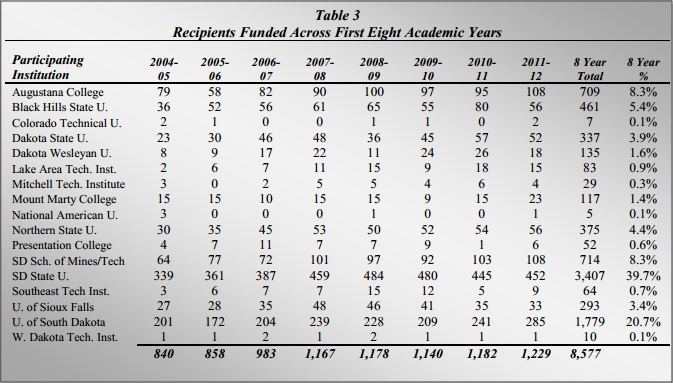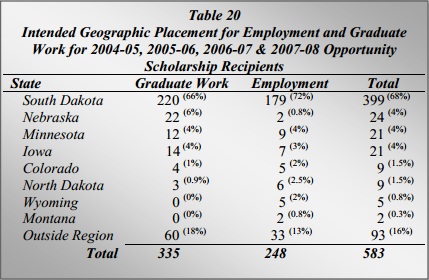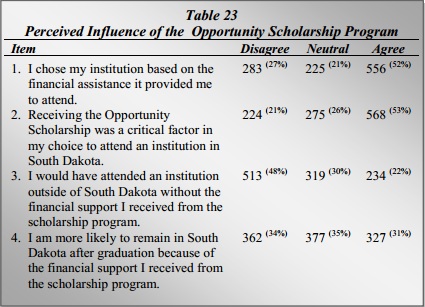Last updated on 2017.01.02
The South Dakota Board of Regents presents the following interesting data in its 2012 report on the Opportunity Scholarship. This scholarship, established by the Legislature in 2003 and first granted in 2004, gives South Dakota students $5000 a year for four years at a South Dakota college or university if they score a 24 or better on the ACT and then keep their college grades up.
First, where do those kids spend the money?

Augustana College in Sioux Falls is the fourth most popular destination for Opportunity Scholarship recipients, predictably behind our two largest state campuses and almost tied with our hard-core engineering campus. With 158 recipients this year attending private campuses, we have contributed $790,000 in taxpayer support to private education. How generous of us.
(But wait: we're paying for someone to go to National American University? Really? I offer an automatic endorsement to any legislative candidate who proposes excluding from the Opportunity Scholarship any for-profit chain school that advertises with annoying jingles. Bonus endorsement for exclusion of campuses run by former managers of corrupt for-profit "colleges".)
So once those Opportunity Scholarship recipients graduate, where do they go?

A majority (57%) of those surveyed head for graduate school, and two-thirds of those students pick a South Dakota program for their masters or doctorate studies. Not bad! A slightly larger percentage of those who are ready to leave the classroom and go to work find suitable employment in South Dakota.
The above table shows was students said their intended plans were at graduation. Compare that now with placement data after graduation based on Department of Labor data for scholarship recipients and non-recipients:

Opportunity Scholarship recipients are somewhat more likely (78.6% versus 69.4%) to be hanging around in South Dakota after graduation than non-recipients. That might suggest an interesting twist on the brain-drain thesis: smarter kids stick around longer! But I wonder: is that just a product of graduate school inertia? Students who attend South Dakota universities naturally build connections that make it easier to get into and attend South Dakota graduate programs. They've saved money on undergrad, they've seen the value in a South Dakota education, and they thus may be less inclined to jet off for grad school elsewhere.
But once they have an advanced degree, can those graduates find work in South Dakota? According to this placement outcomes report from the Board of Regents, folks graduating with advanced degrees from our South Dakota universities appear to leave the state at a slightly higher rate than undergraduates. (Those data are not broken down by Opportunity Scholarship status.)
Lastly, let's look at recipient perceptions of the influence the scholarship program has on their decisions:

These numbers carry an interesting disconnect. A slight majority say the $5000/four-year scholarship was a "critical factor" in their choosing to attend a South Dakota university. Yet only 22% say that they would have gone elsewhere if we hadn't offered the scholarship. I'm all for helping every motivated student bring down the cost of college, but I would love to dig into that 22%, find what distinguishes them from other students, and then see if we could target the scholarship to students like them to increase the difference the Opportunity Scholarship really makes in recruiting top students to South Dakota's higher education system.
Note then the even split between the agrees, neutrals, and disagrees on the scholarship's influence of their desire to remain in South Dakota after graduation. The neutrals and disagrees may be mixed: both groups could include a number of people saying, "No, the scholarship won't affect my choice: I'm staying in/leaving South Dakota regardless." But within that 31% who say they are now more inclined to stay, it would be useful to parse out how many actually do.
The Opportunity Scholarship is a good program, helping reduce student debt and making up for at least a portion of the decline in state support for South Dakota's higher education system. But I'd like to see a more serious examination of the merits of spending state money to pay for private education, as well as a deeper examination of how well the Opportunity Scholarship tackles brain drain.

I am one of the 22% that would have gone else where if I had not received the opportunity scholarship.
Though it is hard to think back to what was on my mind at the time I remember one factor: It would take me roughly two summers to earn $5,000. Though some make $5,000 seem small stretched across the four years, but it was crucial in my decision.
The reason I would have gone else where was strictly monetary. Often, people think South Dakota has the cheapest colleges around. They forget that on the East Coast many of the financial aid packets are calculated on 'need' and you fill out an additional form called the CSS profile. I qualified for far more financial aid out of state due to the use of this more complete look at your families financial situation. To make my point, the $5,000 makes South Dakota more competitive with other school's more robust financial aid programs.
I hope that there is a stipulation that they need to be full time students. Getting the cash and staying part time is just taking advantage of what was intended to be for serious students. NAU advertises that you can be one night a week and be full time. What a joke. Hopefully I missunderstood their add but they are not very serious. Should be fully accredited to get that scholarship. That would eliminate the fourth rate schools.
What is with the 7 Colorado scholarships?
Colorado Technical: that's a for-profit "college" with a satellite campus in Sioux Falls. I would question why we are giving state money for enrollment at any for-profit campus when we have public tech schools offering cheaper and better programs.